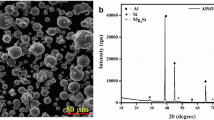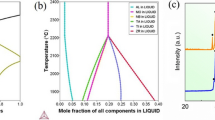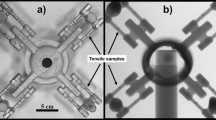Abstract
The aim of this work was to investigate the effect of different cooling rates on the microstructure and solidification parameters of 2024 aluminum alloy. Solidification characteristics are recognized from the cooling curve and its first and second derivative curves which have been plotted using thermal analysis technique. In this study, a mold having high cooling rate was designed and used to simulate the direct-chill casting process. The results of thermal analysis show that the characteristic parameters of Al2024 alloy are influenced by cooling rate. The cooling rates used in the present study range from 0.4 to 17.5 °C s−1. Increasing the cooling rate affects the undercooling parameters both in liquidus and eutectic solidification regions. Investigations showed that solidification parameters such as nucleation temperature, recalescence undercooling temperature, and range of solidification temperature are influenced by variation of cooling rates. Microstructural evaluation was carried out to present the correlation between the cooling rate and dendrite arm spacing.









Similar content being viewed by others
References
Kaufman JG. Introduction to aluminum alloys and tempers. 1st ed. Materials Park: ASM International; 2000.
Kissell JR, Ferry RL. Aluminum structures. 2nd ed. New York: Wiley; 2002.
Nadella R, Eskin DG, Du Q, Katgerman L. Macrosegregation in direct-chill casting of aluminum alloys. Prog Mater Sci. 2008;53:421–80.
Eskin DG. Physical metallurgy of direct chill casting of aluminum alloys. 1st ed. Boca Raton: Taylor & Francis Group; 2008.
Djurdjevic MB, Huber G, Odanovic Z. Synergy between thermal analysis and simulation. J Therm Anal Calorim. 2013;111:1365–73.
Emadi D, Whiting LV, Nafisi S, Ghomashchi R. Applications of thermal analysis in quality control of solidification processes. J Therm Anal Calorim. 2005;81:235–42.
Brown ME, Gallagher PK. Handbook of thermal analysis and calorimetry, vol. 5. 1st ed. Amsterdam: Elsevier B.V; 2008.
Malekan M, Shabestari SG. Computer aided cooling curve thermal analysis used to predict the quality of aluminum alloys. J Therm Anal Calorim. 2010;103:453–8.
Backerud L, Sigworth GK. Recent development in thermal analysis of aluminum casting alloys. AFS Trans. 1989;97:459–64.
Mahfoud M, Prasada Rao AK, Emadi D. The role of thermal analysis in detecting impurity levels during aluminum recycling. J Therm Anal Calorim. 2010;100:847–51.
Backerud L, Krol E, Tamminen J. Solidification characteristics of aluminum alloys, vol. 1. 1st ed. Oslo: Skan Aluminum; 1986.
Flemings MC. Solidification processing. 1st ed. New York: McGraw-Hill; 1974.
Apelian D, Sigworth GK, Whaler KR. Assessment of grain refinement and modification of Al–Si foundry alloys by thermal analysis. AFS Trans. 1984;91:297–307.
Kurz W, Fisher DJ. Fundamentals of solidification. 3rd ed. Aedermannsdorf: Trans Tech Publication Ltd; 1989.
Cruz KS, Meza ES, Fernandes FAP, Quaresma JMV, Casteletti LC, Garcia A. Dendrite arm spacing affecting mechanical properties and wear behavior of Al–Sn and Al–Si alloys directionally solidified under unsteady-state conditions. Metall Mater Trans A. 2010;41:972–84.
Flemings MC, Kattamis TZ, Bardes BP. Dendrite arm spacing in aluminum alloys. AFS Trans. 1991;99:501–6.
Easton M, Davidson C, StJohn D. Effect of alloy composition on the dendrite arm spacing of multicomponent aluminum alloys. Metall Mater Trans A. 2010;41:1528–38.
Gloria D, Gruzleski JE. Time as a control parameter in determination of grain size of 319 Al–Si–Cu foundry alloy. AFS Trans. 1999;107:419–24.
Dedavid BA, Costa EM, Ferreira CR. A study of precipitates formation in AA 380.0 aluminum alloys modified by the addition of magnesium. J Therm Anal Calorim. 2002;67:473–80.
Farahany S, Ourdjini A, Idris MH, Shabestari SG. Computer-aided cooling curve thermal analysis of near eutectic Al–Si–Cu–Fe alloy. J Therm Anal Calorim. 2013;114:705–17.
Shabestari SG, Malekan M. Thermal analysis study of the effect of the cooling rate on the microstructure and solidification parameters of 319 aluminum alloy. Can Metall Q. 2005;44:305–12.
Mackay RI, Djurdjevic MB, Sokolowski JH. Effect of cooling rate on fraction solid of metallurgical reactions in 319 alloy. AFS Trans. 2000;108:521–30.
Shabestari SG, Malekan M. Assessment of the effect of grain refinement on the solidification characteristics of 319 aluminum alloy using thermal analysis. J Alloys Compd. 2010;492:134–42.
Gowri S, Samuel FH. Effect of cooling rate on the solidification behavior of Al-7 Pct Si-SiCp metal–matrix composites. Met Trans A. 1992;23:3369–76.
Porter DA, Easterling KE. Phase transformation in metals and alloys. 2nd ed. London: Chapman & Hall; 1991.
Shewmon PG. Diffusion in solids. 1st ed. New York: McGraw-Hill; 1963.
Hosseini VA, Shabestari SG, Gholizadeh R. Study of the cooling rate on the solidification parameters, microstructure, and mechanical properties of LM13 alloy using cooling curve thermal analysis technique. Mater Des. 2013;50:7–14.
Malekan M, Dayani D, Mir A. Thermal analysis study on the simultaneous grain refinement and modification of 380.3 aluminum alloy. J Therm Anal Calorim. 2013;. doi:10.1007/s10973-013-3189-x.
Charbonnier J. Microprocessor assisted thermal analysis testing of aluminum alloy structures. AFS Trans. 1984;92:907–22.
Gowri S. Comparison of thermal analysis parameters of 356 and 359 alloys. AFS Trans. 1994;102:503–8.
McCartney DJ, Hunt JD. Measurements of cell and primary dendrite arm spacing in directionally solidified aluminum alloys. Acta Metall. 1981;29:1851–63.
Young KP, Kirkwood DH. The dendrite arm spacing of aluminum–copper alloys solidified under steady-state conditions. Metall Trans A. 1975;6:197–205.
Sivarupan T, Caceres CH, Taylor JA. Alloy composition and dendrite arm spacing in Al–Si–Cu–Mg–Fe alloys. Metall Mater Trans A. 2013;44:4071–80.
Acknowledgements
The authors would like to thank Dr. M. Malekan for his assistance. Also, they would like to acknowledge the Center of Excellence for High Strength Alloys Technology (CEHSAT) of Iran University of Science and Technology (IUST).
Author information
Authors and Affiliations
Corresponding author
Rights and permissions
About this article
Cite this article
Ghoncheh, M.H., Shabestari, S.G. & Abbasi, M.H. Effect of cooling rate on the microstructure and solidification characteristics of Al2024 alloy using computer-aided thermal analysis technique. J Therm Anal Calorim 117, 1253–1261 (2014). https://doi.org/10.1007/s10973-014-3867-3
Received:
Accepted:
Published:
Issue Date:
DOI: https://doi.org/10.1007/s10973-014-3867-3




